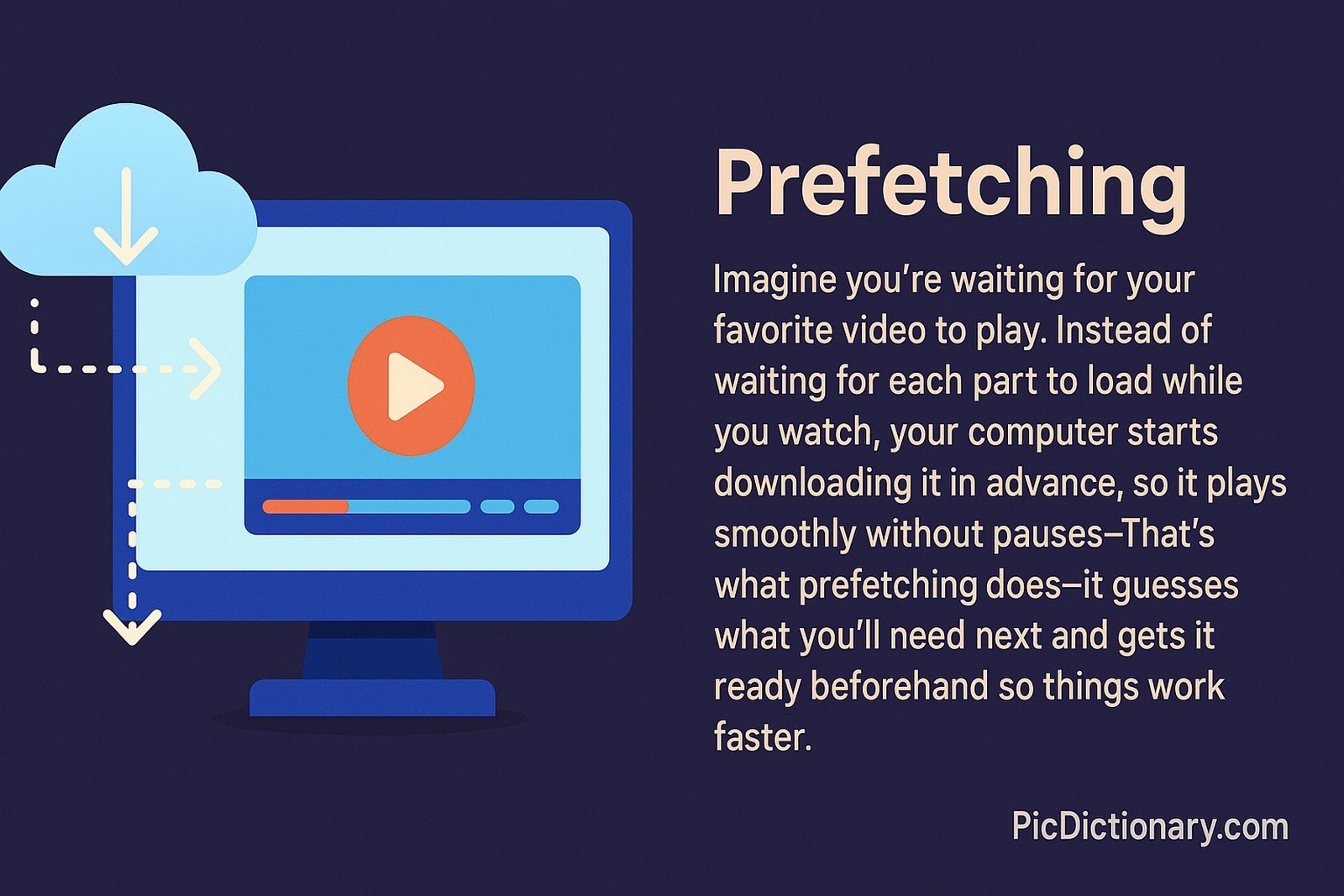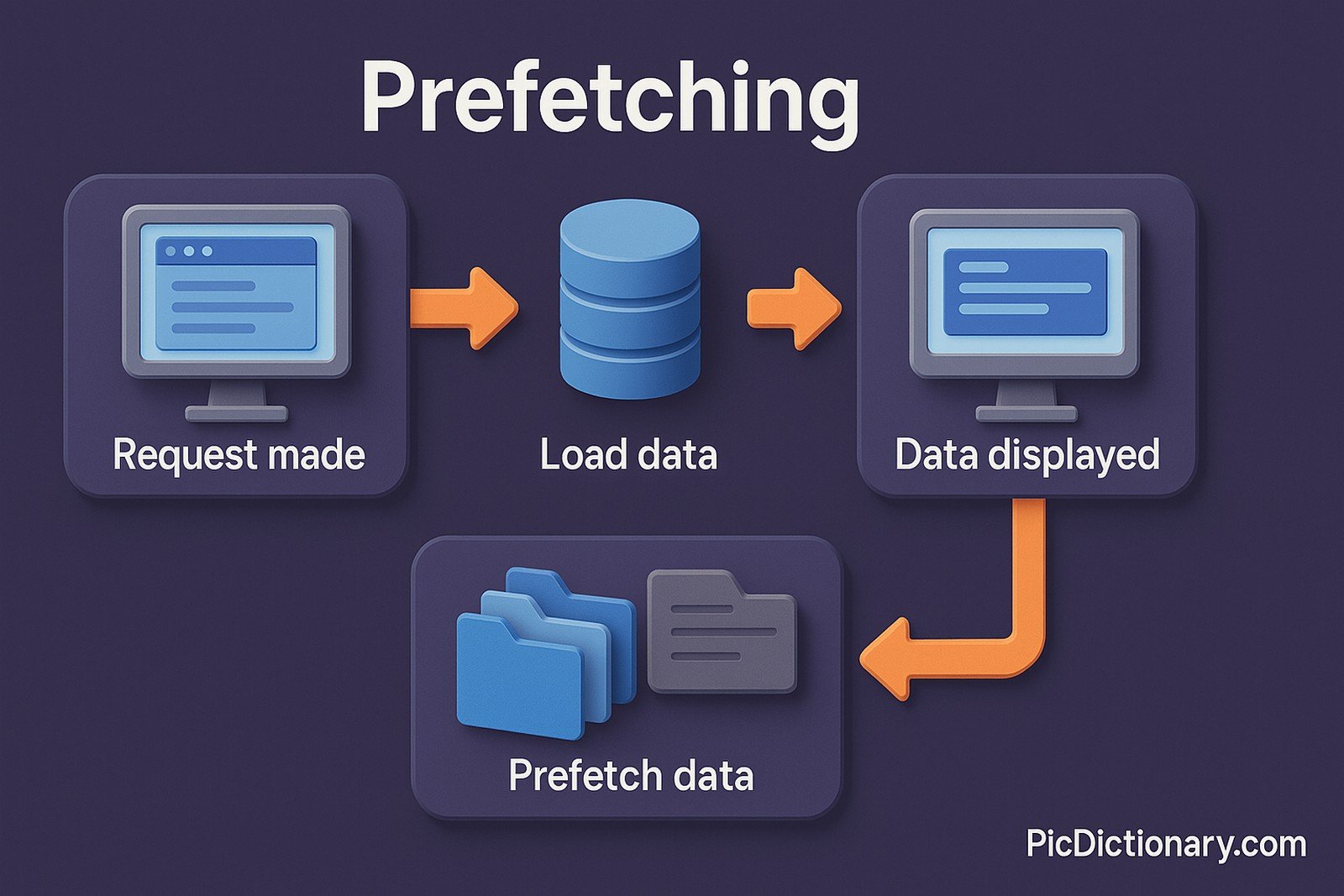Prefetching

Quick Navigation:
- Prefetching Definition
- Prefetching Explained Easy
- Prefetching Origin
- Prefetching Etymology
- Prefetching Usage Trends
- Prefetching Usage
- Prefetching Examples in Context
- Prefetching FAQ
- Prefetching Related Words
Prefetching Definition
Prefetching is a performance optimization technique in computer software that involves loading data or resources before they are actually needed. This anticipatory fetching reduces latency and improves efficiency, especially in applications like web browsers, operating systems, and processors. Prefetching can be implemented in hardware (such as CPU cache prefetching) or software (like preloading website assets). By predicting user behavior or data access patterns, prefetching minimizes waiting times and enhances responsiveness.
Prefetching Explained Easy
Imagine you're waiting for your favorite video to play. Instead of waiting for each part to load while you watch, your computer starts downloading it in advance, so it plays smoothly without pauses. That’s what prefetching does—it guesses what you’ll need next and gets it ready beforehand so things work faster.
Prefetching Origin
The concept of prefetching has been around since the early days of computing, particularly in processor design and memory management. It was extensively studied in the 1960s and 1970s as computer scientists worked on optimizing access speeds for data storage and retrieval.
Prefetching Etymology
The term “prefetching” combines “pre-” (meaning before) and “fetch” (meaning to retrieve). It describes the process of retrieving data before it is explicitly requested.
Prefetching Usage Trends
Prefetching has become increasingly important with the rise of web applications, high-performance computing, and mobile devices. Modern browsers use prefetching to preload web pages, reducing load times. In machine learning, data prefetching accelerates model training by ensuring that datasets are readily available. Prefetching is also essential in gaming, where assets are preloaded to prevent lag.
Prefetching Usage
- Formal/Technical Tagging:
- Computer Architecture
- Operating Systems
- Web Optimization - Typical Collocations:
- "CPU cache prefetching"
- "Web browser prefetching"
- "Memory prefetching"
- "Data prefetching in machine learning"
Prefetching Examples in Context
- A web browser uses prefetching to load the next page in the background, making navigation feel instantaneous.
- Processors prefetch instructions and data into cache memory to speed up execution.
- Mobile apps prefetch images and videos while a user scrolls to ensure smooth viewing.
Prefetching FAQ
- What is prefetching in computing?
Prefetching is the process of loading data or resources before they are needed to reduce waiting time and improve efficiency. - How does prefetching improve performance?
By anticipating future data requests, prefetching reduces access latency, speeding up applications and web pages. - What are the types of prefetching?
Prefetching can be hardware-based (CPU cache prefetching) or software-based (web content prefetching). - How does prefetching work in web browsers?
Browsers analyze user behavior and prefetch linked pages, assets, or DNS queries to speed up browsing. - Can prefetching slow down a system?
Yes, excessive or incorrect prefetching can lead to wasted bandwidth and increased memory usage. - Is prefetching used in gaming?
Yes, games prefetch textures and assets to prevent lag and ensure smooth performance. - What is hardware prefetching?
It’s a CPU technique where data is fetched into cache memory before it is needed, reducing delays. - Does prefetching work for mobile apps?
Yes, apps prefetch content like images or videos to improve user experience. - What is machine learning data prefetching?
It’s a technique where data is preloaded into memory before processing, speeding up training. - How does prefetching differ from caching?
Caching stores frequently used data for quick access, while prefetching predicts future data needs and loads it in advance.

Prefetching Related Words
- Categories/Topics:
- Computer Science
- Web Performance
- CPU Optimization
Did you know?
Google Chrome and other modern browsers use prefetching techniques to load web pages faster. This includes DNS prefetching, where domain name lookups are done in advance, and link prefetching, where certain pages are loaded in the background before you click on them.
PicDictionary.com is an online dictionary in pictures. If you have questions or suggestions, please reach out to us on WhatsApp or Twitter.Authors | Arjun Vishnu | @ArjunAndVishnu

I am Vishnu. I like AI, Linux, Single Board Computers, and Cloud Computing. I create the web & video content, and I also write for popular websites.
My younger brother, Arjun handles image & video editing. Together, we run a YouTube Channel that's focused on reviewing gadgets and explaining technology.



Comments powered by CComment